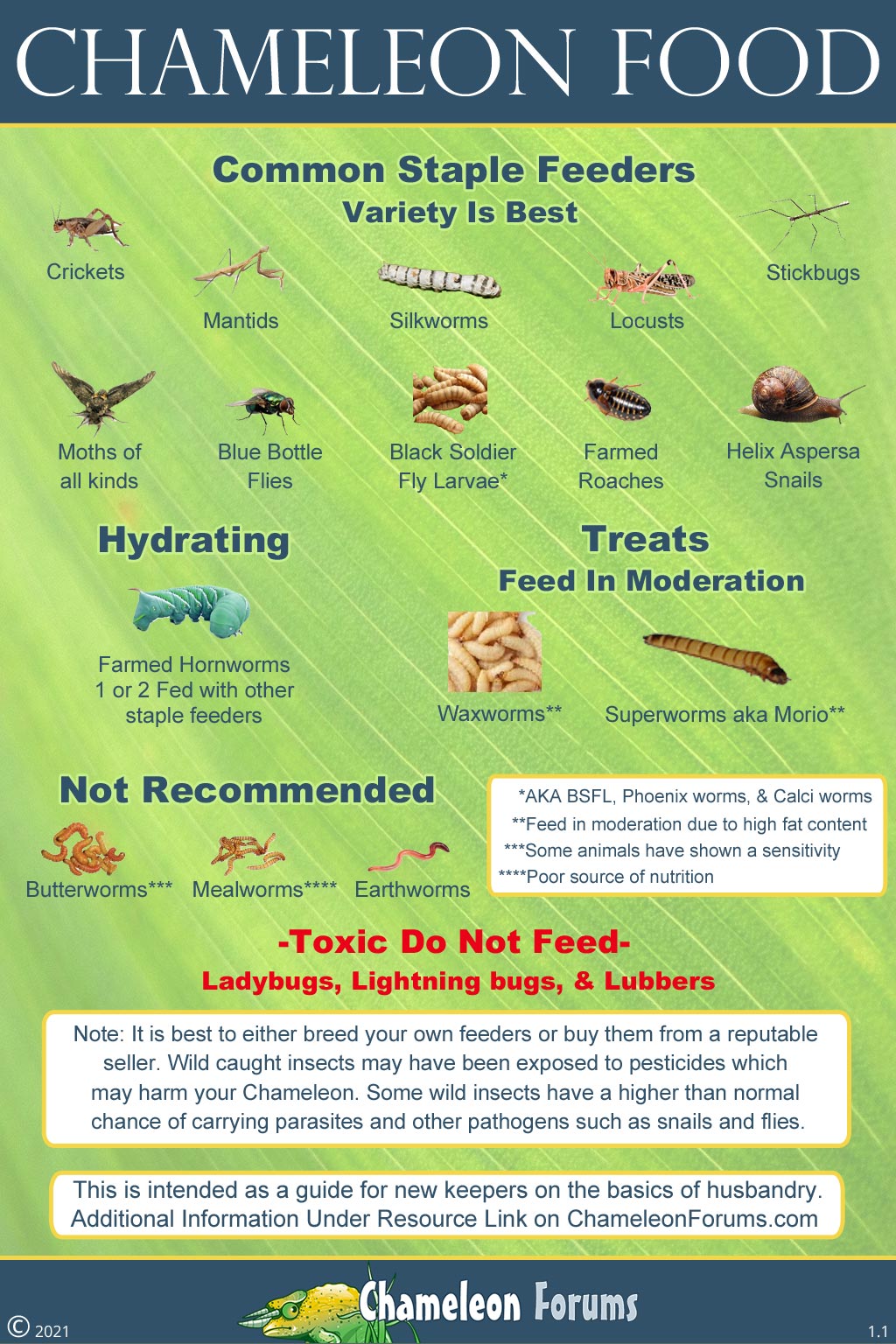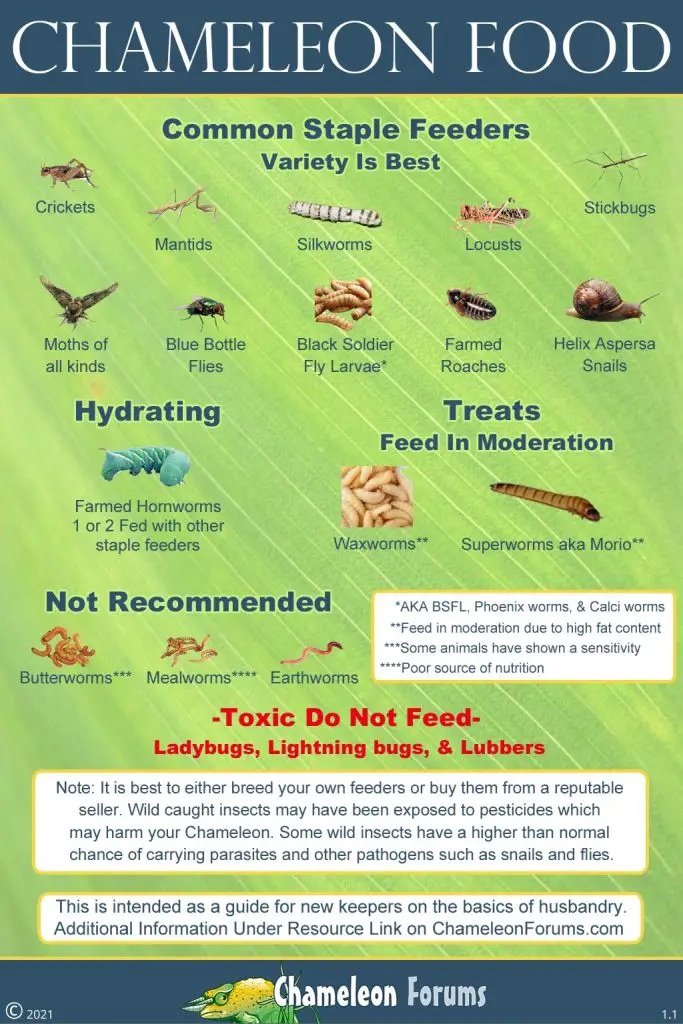Are you a proud owner of a chameleon and unsure about what to feed it? Look no further! Our comprehensive chameleon diet guide has got you covered. From the basic dietary needs of your chameleon to specific feeding techniques and tips, we’ve compiled everything you need to know to keep your chameleon healthy and happy.
Whether you’re a new chameleon owner or an experienced one, our guide has something for everyone. With our easy-to-follow instructions and expert advice, you’ll be able to provide your chameleon with a well-rounded and nutritious diet that will help them thrive. So let’s dive in and learn all about the chameleon diet!
A chameleon’s diet consists mainly of insects, but they can also eat fruits and vegetables. It is important to provide them with a variety of insects, such as crickets, mealworms, and waxworms, to ensure they are getting all the necessary nutrients. It is also recommended to dust their food with a calcium supplement. Avoid feeding them wild-caught insects, as they may have been exposed to pesticides. Provide fresh water daily.

Chameleon Diet Guide: Everything You Need to Know
Chameleons are fascinating creatures with unique dietary needs. As a chameleon owner, it’s important to understand what to feed your pet to ensure they remain healthy and happy. In this comprehensive guide, we’ll cover everything you need to know about chameleon diets and how to keep your pet well-fed.
What Do Chameleons Eat?
Chameleons are insectivores, which means they primarily eat insects. However, they also require a variety of other nutrients to stay healthy, including vitamins, minerals, and water. When it comes to feeding your chameleon, it’s important to provide a balanced diet that meets all of their nutritional needs.
One of the best ways to ensure your chameleon gets the right nutrients is to provide a variety of live insects. This can include crickets, mealworms, waxworms, roaches, and more. It’s important to vary the insects you provide to ensure your chameleon is getting a range of nutrients.
In addition to insects, many chameleon owners also provide plants as a source of hydration and additional nutrients. Some good options include hibiscus, pothos, and ficus. However, it’s important to research which plants are safe for your specific chameleon species before feeding them.
How Much Should You Feed Your Chameleon?
The amount you should feed your chameleon depends on their age, size, and activity level. As a general rule, juvenile chameleons should be fed more frequently than adults. This is because they are still growing and require more nutrients to support their development.
For adult chameleons, you should aim to feed them around 5-6 insects per day. However, this can vary depending on their size and activity level. It’s important not to overfeed your chameleon, as this can lead to obesity and other health problems.
Supplements for Chameleons
In addition to a balanced diet, your chameleon may require supplements to ensure they are getting all of the necessary nutrients. One of the most important supplements for chameleons is calcium. This helps to support healthy bone growth and prevent metabolic bone disease.
You can provide calcium supplements in a few different ways. One option is to dust your chameleon’s insects with calcium powder before feeding them. Another option is to provide a calcium supplement in the form of a liquid or powder that can be added to their water.
Water and Hydration
Chameleons require plenty of water to stay hydrated and healthy. However, they may not always drink from a water dish, so it’s important to provide water in other ways. One option is to mist their enclosure with water several times a day. This can help to simulate rain and encourage your chameleon to drink.
Another option is to provide a dripper system. This is a device that slowly drips water into your chameleon’s enclosure, providing a source of hydration that they can drink from directly. It’s important to change the water in the dripper regularly to prevent bacteria growth.
Common Foods to Avoid
While chameleons can eat a variety of insects and plants, there are some foods that should be avoided. These include:
– Toxic plants: Some plants can be toxic to chameleons and should be avoided. Examples include ivy, oleander, and daffodils.
– Wild-caught insects: Insects caught outside may have been exposed to pesticides or other harmful substances.
– Prey that is too large: Chameleons should only eat insects that are smaller than the space between their eyes. This helps to prevent choking and other health problems.
The Benefits of a Balanced Chameleon Diet
A balanced chameleon diet is essential for your pet’s health and well-being. When your chameleon is getting all of the necessary nutrients, they will be more active, alert, and vibrant in color. They will also be less likely to develop health problems such as metabolic bone disease or obesity.
By providing a variety of live insects, plants, and supplements, you can ensure your chameleon is getting all of the necessary nutrients for a healthy life.
Chameleon Diet Vs Other Reptile Diets
Compared to other reptiles, chameleons have a unique diet that is primarily made up of insects. This can make it more challenging to provide a balanced diet, as insects vary in their nutritional content. However, with proper research and planning, it is possible to provide a well-rounded diet for your chameleon.
In contrast, other reptiles such as bearded dragons or tortoises may have a more varied diet that includes fruits and vegetables in addition to insects. These animals also have different nutritional needs than chameleons, so it’s important to research and understand the specific dietary requirements of each species.
Chameleon Diet FAQs
Q: Can chameleons eat fruit?
A: While some fruits are safe for chameleons to eat in small amounts, they should not make up a significant portion of their diet. Chameleons are primarily insectivores and require a diet that is high in protein.
Q: How often should I feed my chameleon?
A: The frequency of feeding depends on your chameleon’s age, size, and activity level. Juvenile chameleons may require multiple feedings per day, while adult chameleons may only need to be fed once per day.
Q: Can chameleons drink from a water dish?
A: While some chameleons may drink from a water dish, many prefer to drink from moving water sources such as mist or a dripper system.
In conclusion, providing a balanced and varied diet is essential for the health and well-being of your chameleon. By understanding their dietary needs and providing a range of live insects, plants, and supplements, you can help your pet thrive.
Frequently Asked Questions
Here are some common questions about chameleon diets and feeding habits.
What should I feed my chameleon?
Chameleons are insectivores, which means they eat insects. The best insects to feed your chameleon are crickets, roaches, and mealworms. You can also give them waxworms or superworms as a treat, but don’t feed them too many as they are high in fat. It’s important to gut-load your insects before feeding them to your chameleon. This means feeding them a nutritious diet a few hours before feeding them to your chameleon, so your chameleon gets all the nutrients it needs.
It’s also important to provide your chameleon with a variety of insects to ensure they are getting a balanced diet. You can also dust their food with calcium and vitamin supplements to prevent nutritional deficiencies.
Can I feed my chameleon fruits and vegetables?
While chameleons are primarily insectivores, some species will also eat fruits and vegetables. However, it’s important to remember that chameleons have specific dietary requirements and too much of certain fruits and vegetables can be harmful to them. Fruits like bananas and grapes are high in sugar and should only be given in small amounts as a treat. Vegetables like spinach and kale contain oxalates, which can bind to calcium and lead to nutritional deficiencies.
If you want to give your chameleon fruits and vegetables, make sure to do your research and only give them small amounts of safe options like carrots and squash. It’s also important to gut-load any insects that you will be feeding your chameleon with these fruits and vegetables.
How often should I feed my chameleon?
The frequency of feeding your chameleon depends on its age and size. Hatchlings and juvenile chameleons should be fed every day or every other day, while adult chameleons can be fed every other day or every few days. It’s important to observe your chameleon’s eating habits and adjust their feeding schedule accordingly. If they are consistently leaving food uneaten, you may be overfeeding them.
It’s also important to provide your chameleon with fresh water every day and mist their enclosure to maintain proper hydration.
Can I feed my chameleon wild-caught insects?
While it’s possible to feed your chameleon wild-caught insects, it’s not recommended. Wild-caught insects can carry parasites and diseases that can be harmful to your chameleon. It’s best to purchase insects from a reliable source and gut-load them before feeding them to your chameleon. If you must feed your chameleon wild-caught insects, make sure to properly clean and gut-load them before feeding.
It’s also important to avoid feeding your chameleon insects that have been exposed to pesticides or other chemicals.
What are some signs that my chameleon is not eating well?
If your chameleon is not eating well, there are several signs to look out for. A decrease in appetite is the most obvious sign, but you may also notice weight loss, lethargy, and a lack of energy. Your chameleon may also have sunken eyes, wrinkled skin, or a change in color. If you notice any of these signs, it’s important to take your chameleon to a veterinarian who specializes in reptile care to determine the underlying cause and provide treatment.
It’s also a good idea to maintain a feeding log to keep track of your chameleon’s eating habits and identify any changes or patterns.
In conclusion, understanding the chameleon diet is crucial for the health and well-being of your pet. By providing a balanced and nutritious diet, you can ensure that your chameleon stays healthy and happy. Remember to offer a variety of insects, fruits, and vegetables, and to avoid feeding them toxic or low-nutrient foods.
If you’re new to chameleon care, it’s important to consult with a veterinarian or experienced reptile owner to ensure that you’re providing the best possible diet for your pet. With a little research and effort, you can create a diet plan that meets all of your chameleon’s nutritional needs.
By following these guidelines and providing your chameleon with a healthy diet, you can help them thrive in their environment. So, take the time to learn about your pet’s dietary requirements and give them the best possible care they deserve.

